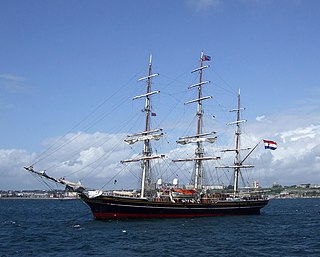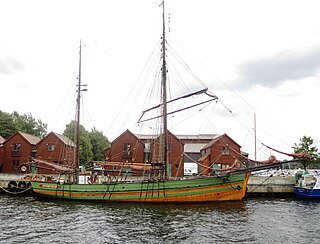
A lightvessel, or lightship, is a ship that acts as a lighthouse. They are used in waters that are too deep or otherwise unsuitable for lighthouse construction. Although some records exist of fire beacons being placed on ships in Roman times, the first modern lightvessel was off the Nore sandbank at the mouth of the River Thames in London, England, placed there by its inventor Robert Hamblin in 1734. The type has become largely obsolete; lighthouses replaced some stations as the construction techniques for lighthouses advanced, while large, automated buoys replaced others.

Cutty Sark is a British clipper ship. Built on the River Leven, Dumbarton, Scotland in 1869 for the Jock Willis Shipping Line, she was one of the last tea clippers to be built and one of the fastest, coming at the end of a long period of design development for this type of vessel, which ended as steamships took over their routes. She was named after the short shirt of the fictional witch in Robert Burns' poem Tam o' Shanter, first published in 1791.

Thermopylae was an extreme composite clipper ship built in 1868 by Walter Hood & Co of Aberdeen, to the design of Bernard Waymouth of London. Designed for the China tea trade, she set a speed record on her maiden voyage to Melbourne of 63 days, still the fastest trip under sail.

Blackadder was a clipper, a sister ship to Hallowe'en, built in 1870 by Maudslay, Sons & Field at Greenwich for Jock Willis & Sons.

Suomen Joutsen is a steel-hulled full-rigged ship with three square rigged masts. Built in 1902 by Chantiers de Penhoët in St. Nazaire, France, as Laënnec, the ship served two French owners before she was sold to German interest in 1922 and renamed Oldenburg. In 1930, she was acquired by the Government of Finland, refitted to serve as a school ship for the Finnish Navy and given her current name. Suomen Joutsen made eight long international voyages before the Second World War and later served in various support and supply roles during the war. From 1961 on she served as a stationary seamen's school for the Finnish Merchant Navy. In 1991, Suomen Joutsen was donated to the city of Turku and became a museum ship moored next to Forum Marinum.

Alexander von Humboldt is a German sailing ship originally built in 1906 by the German shipyard AG Weser at Bremen as the lightship Reserve Sonderburg. She was operated throughout the North and Baltic Seas until being retired in 1986. Subsequently, she was converted into a three masted barque by the German shipyard Motorwerke Bremerhaven and was re-launched in 1988 as Alexander von Humboldt. In 2011 the ship was taken off sail-training and sent to the Caribbean for the charter business, then she was converted to a botel.

The Stad Amsterdam is a three-masted clipper that was built in Amsterdam, the Netherlands, in 2000 at the Damen Shipyard.

Sevenstones Lightship is a lightvessel station off the Seven Stones Reef which is nearly 15 miles (24 km) to the west-north-west (WNW) of Land's End, Cornwall, and 7 miles (11 km) east-north-east (ENE) of the Isles of Scilly. The reef has been a navigational hazard to shipping for centuries with seventy-one named wrecks and an estimated two hundred shipwrecks overall, the most infamous being the oil tanker Torrey Canyon on 18 March 1967. The rocks are only exposed at half tide. Since it was not feasible to build a lighthouse, a lightvessel was provided by Trinity House. The first was moored near the reef on 20 August 1841 and exhibited its first light on 1 September 1841. She is permanently anchored in 40 fathoms (73 m) and is 2.5 miles (4.0 km) north-east (NE) of the reef. Since 1987, the Sevenstones Lightship has been automated and unmanned.

The tallship Søren Larsen is a brigantine built in 1949 in Nykøbing Mors, Denmark. Her current homeport is Sydney, Australia.

The SV Tenacious is a modern British wooden sail training ship, specially designed in the 1990s. When completed in 2000, it was the largest wooden ship to be built in the UK for over 100 years.

The Sail Training Vessel Kaliakra is a barquentine, built in 1984 at the Gdańsk Shipyard, after the plans of the Polish technical designer Zygmunt Choreń. She is a property of Bulgarian Maritime Training Centre and is operated by Navigation Maritime Bulgare, Bulgaria. The ship's home port is Varna, Bulgaria.

HMAS Bundaberg, named after the city of Bundaberg, was an Armidale class patrol boat of the Royal Australian Navy (RAN). The ship was built in Henderson, Western Australia, and was commissioned into the RAN in March 2007. Based at HMAS Cairns, Bundaberg spent much of her career deployed as part of border protection and fisheries protection patrols as part of Operation Resolute. In addition, the patrol boat was involved in several national and multinational training exercises, visited Vanuatu in 2011, tracked a suspected drug-smuggling vessel that led to a multimillion-dollar seizure, and participated in the International Fleet Review 2013. In August 2014, a large fire broke out on the ship while she was undergoing refit. Extensive damage from the fire led to the ship's decommissioning in December 2014.

R. Tucker Thompson is a gaff-rigged topsail schooner based in Opua, Bay of Islands, New Zealand. She is operated as a non-for profit charitable trust and owned by the R. Tucker Thompson Sail Training Trust. The mission of the trust is “Learning for Life through the Sea”. The ship is used for tourism day sails in the Bay of Islands from October through April and for sail training activities between May and September. Youth sail training is particularly focused at youth from the Tai Tokerau Northland region of New Zealand. She is a member of the Australian Sail Training Association (AUSTA), and participated in the American Sail Training Association (ASTA) West Coast Tall Ships Challenge events in 2002 and 2005.

Tradewind is a Dutch topsail schooner. She was built in the Netherlands in 1911 as a herring lugger named Sophie Theresia.

The tall ship Spirit of New Zealand is a steel-hulled, three-masted barquentine from Auckland, New Zealand. It was purpose-built by the Spirit of Adventure Trust in 1986 for youth development. It is 42.5 m in total length and carries a maximum of 40 trainees and 14 crew on overnight voyages. The ship's home port is Auckland, and it spends most of its time sailing around the Hauraki Gulf. During the summer season, it often sails to the Marlborough Sounds and Nelson, at the top of the South Island.

Bounty was built in 1977/78 for the movie The Bounty starring Mel Gibson and Anthony Hopkins. The ship launched on 16 December 1978 and was decommissioned in 2017.

Southern Swan is a traditional Baltic trader, currently rigged as a three-masted barquentine. She is typical of coastal trading ships from the era 1840s to 1940s.

The First Fleet Reenactment Voyage was a project to assemble a fleet of tall ships to sail from England to Australia in a historical reenactment of the First Fleet that colonised Australia in 1788. The reenactment was first conceived in 1977 and organised to commemorate Australia's bicentenary of colonisation. Despite opposition and minimal funding from the Australian government, the project attracted the support of high-profile adventurers Thor Heyerdahl, Alan Villiers, and Sir Edmund Hillary, as well as former Australian political figures and the British Royal Family. Several corporations offered to sponsor the fleet as a whole or individual ships, and additional money was raised by selling "training crew" berths for the various legs of the voyage.

Anna Kristina is a Norwegian-flagged, galeas-rigged Hardangerjakt. Originally named Dyrafjeld, the sloop-rigged vessel was built on a Norwegian farm in 1889. The ship's early career was as a cargo ship in the Hardanger region, with occasional voyages as far afield as Russia. She was sold to new owners and rerigged as a galeas in the late 1920s. The sails were removed during World War II, but continued in merchant service until the mid-1970s. After a series of accidents, the vessel was laid up, then sold to new owners, who restored the vessel and renamed her Anna Kristina. Charter work occurred throughout the 1980s, including involvement in the First Fleet Re-enactment Voyage.

Admiral Karpfanger was a German four-masted barque that was a cargo ship and sail training ship. She was built near Bremerhaven in 1908 as l'Avenir, which was the name that she bore until 1937. She spent most of her career with the Association Maritime Belge, SA.



















